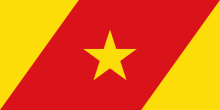Dehana
Dehana (Amharic: ደሀና transliterated as “Poor Come Here” in Amharic ) is one of the woredas in the Amhara Region of Ethiopia. It is named for one of the five clans of the Agaw.[2] Part of the Wag Hemra Zone, Dehana is bordered on the south by the Semien (North) Wollo Zone, on the west by the Tekezé River which separates it from the Debub (South) Gondar Zone and the Semien (North) Gondar Zone, on the north by Zikuala, on the northeast by Soqota, and on the east by Gazbibla. Gazbibla woreda was separated from Dehana.
Dehana ደሀና | |
|---|---|
Woreda | |
 Flag | |
| Zone | Wag Hemra |
| Region | Amhara Region |
| Area | |
| • Total | 1,643.07 km2 (634.39 sq mi) |
| Population (2012 est.) | |
| • Total | 118,793 |
The major town in Dehana is Amde Werq. The Battle of Qwila, where Wagshum Gobeze defeated and killed his rival Tiso Gobeze of Welkait, Gonder in late 1867, was fought in this woreda.
Demographics
Based on the 2007 national census conducted by the Central Statistical Agency of Ethiopia (CSA), this woreda has a total population of 109,725, an increase of 13.67% over the 1994 census, of whom 54,658 are men and 55,067 women; 4,207 or 3.83% are urban inhabitants. With an area of 1,643.07 square kilometers, Dehana has a population density of 66.78, which is greater than the Zone average of 47.15 persons per square kilometer. A total of 26,436 households were counted in this woreda, resulting in an average of 4.15 persons to a household, and 25,520 housing units. The majority of the inhabitants practiced Ethiopian Orthodox Christianity, with 99.72% reporting that as their religion.[3]
The 1994 national census reported a total population for this woreda of 96,526 in 23,987 households, of whom 48,613 were men and 47,913 were women; 2,084 or 2.16% of its population were urban dwellers. The two largest ethnic groups reported in Soqota were the Amhara (98.74%), and the Agaw/Kamyr (1.11%); all other ethnic groups made up 0.15% of the population. Amharic was spoken as a first language by 99.16%. The majority of the inhabitants practiced Ethiopian Orthodox Christianity, with 99.8% reporting that as their religion.[4]
Notes
- Geohive: Ethiopia Archived 2012-08-05 at the Wayback Machine
- According to the list provided by James Bruce, Travels to Discover the Source of the Nile (1805 edition), vol. 3, p. 330
- Census 2007 Tables: Amhara Region Archived November 14, 2010, at the Wayback Machine, Tables 2.1, 2.4, 2.5, 3.1, 3.2 and 3.4.
- 1994 Population and Housing Census of Ethiopia: Results for Amhara Region, Vol. 1, part 1 Archived November 15, 2010, at the Wayback Machine, Tables 2.1, 2.7, 2.10, 2.13, 2.17, Annex II.2 (accessed 9 April 2009)